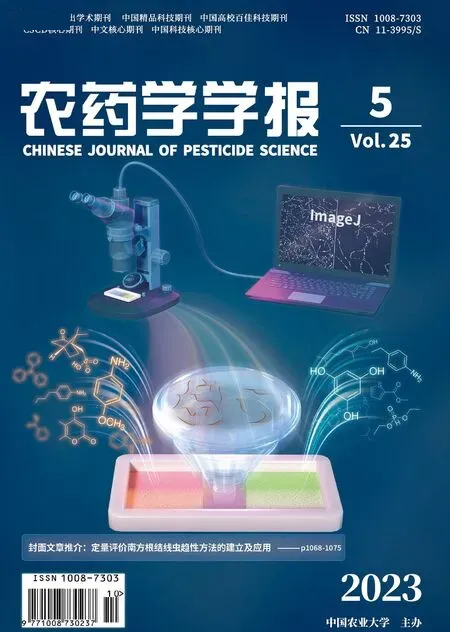草莓褐色叶斑病病原菌Pilidium lythri 鉴定及室内防治药剂筛选
2023-10-19闫奕彤孙浚源李福鑫张桂军黄中乔高慧鸽
闫奕彤, 孙浚源, 李福鑫, 张桂军,闫 哲, 黄中乔, 高慧鸽, 毕 扬*,
(1.北京农学院 农业农村部北方城市重点实验室,北京 102206;2.中国农业大学 植物病理学系,北京 100193)
0 Introduction
Strawberry (Fragaria×ananassaDuch.) is an important commercial fruit crop that is widely grown in temperate regions worldwide.Over the past twenty years, the planting area and yield of strawberry have grown rapidly.According to the latest statistics from FAOSTAT(https://www.fao.org/faostat/zh/#home) in 2020,strawberry planting areas have reached more than 100 000 hectares in China.Meanwhile, strawberry production was up to 3000 000 tons per year in China, ranking top of the world[1].During the growth period, strawberries are affected by a variety of fungal pathogens, for example,Botrytis cinereaPers.,Colletotrichumspp.,andVerticillium dahliaeKleb.[2].Pilidium lythri,previously namedPilidium concavumandHainesia lythri, has been reported to cause strawberry tanbrown rot disease worldwide.Strawberry tan-brown rot disease was first reported in Japan, and since then reported in several other countries such as Poland,Brazil, and Belgium[3-7].In China, strawberry tanbrown rot disease caused byP.lythrihas been reported only in Beijing so far[8].
In addition to strawberry,P.lythrican also infect more than ten hosts, includingOlea europaea,Fallopia japonica,Hieracium caespitosum,Bergenia crassifolia,Paeonia suffruticosa,Eucalyptussp.,Rosa rugosa,Prunus domestica,Paeonia lactiflora,Greyia radlkoferi,Aesculus hippocastanum,Vaccinium corymbosumandCornus mas[5-6,8-9].P.lythriinfects strawberry leaves, stems, fruits, and roots.After the initial acute infection, a circular,water-stained brown spot emerges in the center or margin of strawberry leaves[6-7].
The application of chemical fungicides is an effective method for managing strawberry diseases.However, the development of fungicide resistance has compromised this control strategy.Besides, considering the safety of fresh strawberry, there are also some limitations to the use of chemical fungicides in the field.Currently, the management ofP.lythriheavily relies on the application of effective fungicides and host resistance.However, there is little research on the chemical control of strawberry tan-brown rot disease caused byP.lythri.
The purpose of this study is to identify and characterizeP.lythriassociated with tan-brown leaf spot disease of strawberry in China based on morphological, molecular and pathogenic characteristics and to evaluate the inhibitory activity of azoxystrobin, chlorothalonil, epoxiconazole, difenoconazole, mancozeb, myclobutanil, prochloraz, tebuconazole and SYP-14288 against this fungusin vitro.
1 Materials and methods
1.1 Medium
PDA:200 g potato, 20 g dextrose, and 15 g agar in 1000 mL distilled water.
1.2 Fungicides
Technical-grade azoxystrobin (95% a.i.; Syngenta Biotechnology Co., Ltd., Shanghai, China),chlorothalonil (98% a.i.; Henan Chunguang Agrochemicals Co., Ltd., Henan, China),difenoconazole (98% a.i.; Hangzhou Yulong Agrochemicals Co., Ltd., Zhejiang, China),epoxiconazole (97.8% a.i.; Henan Zhongzhou Seed Technology Development Co., Ltd., Henan, China),mancozeb (98.5% a.i.; Hebei Hesen Chemical Co.,Ltd., Hebei, China), myclobutanil (98% a.i.; Henan Zhongyuan Germplasm Factory, Henan, China),prochloraz (97% a.i.; Hangzhou Qingfeng Agrochemicals Co., Ltd., Zhejiang, China), SYP-14288 (97% a.i.; Shenyang Research Institute of Chemical Industry, Shenyang, China), and tebuconazole (98% a.i.; Jiangsu Fengdeng Pesticide Co., Ltd., Jiangsu, China) were dissolved respectively in dimethyl sulfoxide (DMSO) to make stock solutions and were stored at 4 ℃ in the dark.
1.3 Diseased sample collection and pathogen isolation
A total of 90 diseased samples were collected randomly from strawberry fields exhibiting typical symptoms of tan-brown rot disease in Changping District, Beijing; Zhucheng County, Shandong Province; and Loudi City, Hunan Province, China in 2015-2017, with 30 samples from each district.Among 26 isolates ofP.lythri, one isolate (BJ-4) was from Beijing City, nine isolates (HNLD-1 to HNLD-7, HNLD-9, HNLD-12) were from Hunan Province,and 16 isolates (SD17-2 to SD17-12, SD14 to SD18)were from Shandong Province (Table 1).The infectedparts were cut into pieces (0.5 cm in diameter) from the edges of lesions, soaked into sodium hypochlorite(1%,V:V) for 30 s, sterilized with 70% (V:V)ethanol for 60 s and washed with distilled water for 3 times with 10 s each time.The detached samples were dried on sterile paper and placed on PDA plates, and incubated at 25 ℃ in the dark for 7 days.Finally, the isolates were purified by single spores to obtain pure cultures[10]and transferred to PDA slants covered with sterile mineral oil for long-term storage under -20 ℃at Beijing University of Agriculture.

Table 1 Information of ITS and LSU gene sequence of P.lythri strains used for phylogenetic analysis
1.4 Morphological description
The isolates were inoculated on PDA plates at 28 ℃in the dark for 5 days.The shape and color of the colony, aerial mycelium, and conidium were recorded.For microscopic features, Riddell’ slide culture techniques were used[22].Each microstructure was measured 30 times and pictures of related properties were taken using an Olympus digital camera (DM-21) mounted on an optical microscope(Olympus BX-41, Olympus Optics).
1.5 Pathogenicity analysis
The pathogenicity of the isolates was verified by Koch’s Principle[23].Detached and untreated strawberry (cv.Benihopp) fruits and leaves were used as inoculation materials, which were cleaned with sterile water, surface disinfected with 0.8% (V:V)sodium hypochlorite for 2 minutes, rinsed with sterile water three times, and dried.Five leaves and fruits were inoculated with each isolate by placing the mycelial plugs (5 mm in diameter) that were cut with a cork borer from the margin of a five-day-old colony of isolates.Another five leaves and fruits were inoculated with 5-mm PDA plugs as the control group.After incubation in a chamber (Shanghai Yiheng Technical Co., Ltd., Shanghai, China) with 80% relative humidity, 12 h light/12 h darkness cycle at 28 ℃ for 5 days,P.lythriwas reisolated as described above to confirm the pathogen identity.The experiment was performed twice.
1.6 Internal transcribed spacer (ITS) and large subunit (LSU) sequence analysis
Single-spore cultures developed on PDA medium were used for DNA extraction, using the rapid genome DNA extraction kit purchased from Beijing Biomed Biotechnology Co., Ltd.(Beijing, China).The DNA concentration of each isolate was determined by Nano-Drop ND-1000 Spectrophotometer (NanoDrop Technologies) in three replicates, and a suitable dilution was prepared.In the polymerase chain reaction (PCR), the partial regions of two loci, ITS rDNA and LSU rDNA, were amplified using the primers ITS5 (GGAAGTAAAAGTCGTAACAAGG) +ITS4 (TCCTCCGCTTATTGATATGC)[24]and LR0R(GTACCCGCTGAACTTAAGC) + LR7 (TACTA CCACCAAGATCT)[25-26].All PCRs are performed in a total volume of 25 μL, consisting of 50 ng genomic DNA, 1 × Dream Taq Green PCR Mastermix(Fermentas) and 0.2 μm of each primer.The LSU and ITS PCR conditions were described by de Gruyter et al.[27]and Woudenberg et al.[28], respectively.PCR products were confirmed by electrophoresis on a 1.0% (V:V) agarose gel in 1 × Tris-Borate-EDTA buffer and sequenced at Beijing Liuhe BGI Co., Ltd.(Beijing, China).
1.7 Phylogenetic analysis
The sequences of the isolates obtained in this study were spliced and compared by DNAMAN 6.0 (Lynnon Biosoft, USA).The assembled sequences were used as a query for BLAST (Mega BLAST from NCBI).The subjects with high similarity, including ex-type and ex-epitype samples were then downloaded from GenBank (Table 1).MrBayes Ver.3.2.1 were used to build the Bayesian Inference (BI) phylogenetic trees for ITS and LSU genes amplified in the above isolates.The phylogenetic tree was rooted withChaetomella raphigeravoucher BPI 843541 (GenBank No.AY487077).
1.8 Fungicide sensitivity tests
Fungicide sensitivity was determined by the mycelial growth rate methodin vitro[29].Mycelial plugs (5 mm in diameter) were transferred from the leading edge of an actively growing colony onto a series of PDA plates amended with serial concentrations of azoxystrobin, chlorothalonil, difenoconazole, epoxiconazole,myclobutanil, mancozeb, prochloraz, SYP-14288, or tebuconazole (Table 2).DMSO-amended PDA was included in the control group.The final DMSO concentration in all plates in this study was adjusted to 0.1% (V:V), which did not affect the growth ofP.lythri.After incubation at 25 ℃ in the dark for 8 days,the colony diameter was measured by cross method.Each treatment was replicated four times, and the experiment was conducted twice.The median effective concentration (EC50) was calculated by regressing the percentage of growth inhibition against the log fungicide concentration.
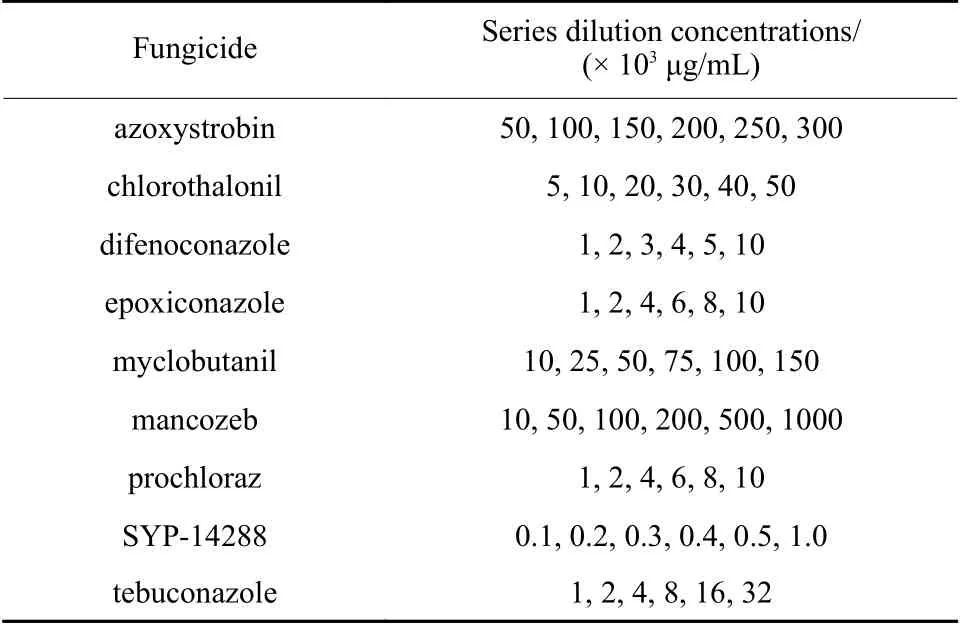
Table 2 Initial concentration and series dilution concentrations of fungicides
1.9 Data analysis
Statistical analyses were performed using the SAS package (SAS Institute, Cary, NC) Ver.9.2.The EC50values for each isolate were calculated by using PROC REG for linear regression.Mean values were compared using Fisher’s least significant difference(LSD) test at a significance level ofα= 0.05.
2 Results and analysis
2.1 Morphology and cultural characteristics
The colony of the tested isolates was circular with regular edges and exhibited white-to-cinnamon sparse aerial mycelium on PDA medium.In addition, a creamy-to-brown circle appeared around the center of the colony (Fig.1 a, b).Conidia were unicellular,hyaline, smooth, and allantoid with a little bent pointing at both sides.The size of the conidia was 8-12 μm in length and 2.0-2.5 μm in width (Fig.1 c).The sexual stage was not observed.
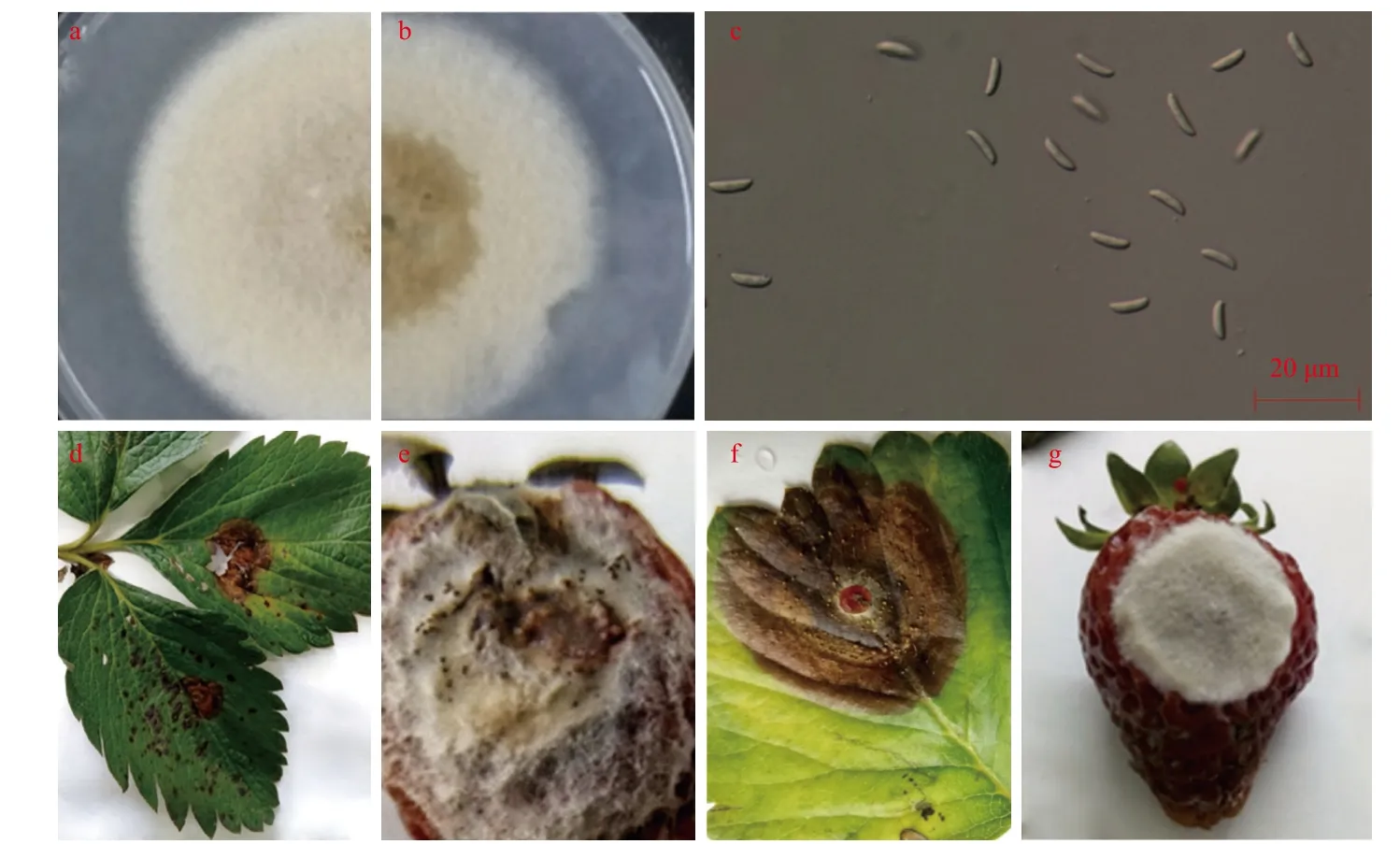
Fig.1 Tan-brown leaf spot disease and causal pathogen on strawberry
2.2 Pathogenicity analysis
Field symptoms of strawberry disease caused byP.lythriwere similar to anthracnose.In the early stage of the disease, circular and brown spots are formed at the center or edge of the leaves.However, unlike anthracnose fruit rot with orange conidial masses, the fruit rotted byP.lythriproduces pink conidial masses(Fig.1 d, e).The 26 isolates were inoculated on healthy strawberry leaves and fruits.At the onset of infection, the spots on the margin or in the middle of leaves were very small, round, and water-soaked lesions.The spots enlarged gradually up to 1-3 cm in diameter, and the color ranged from brown to dark brown, with pink spore masses forming at the late stage (Fig.1 f).On the fruit surface, white hyphae appeared at the early stage, and a white layer of mold formed at the late stage (Fig.1 g).The pathogen was reisolated and purified from diseased leaves and fruits.The colony characteristics obtained were the same as those of the originally isolated pathogen.
2.3 Phylogenetic analysis
Three isolates were used for the phylogenetic analysis based on ITS and the concatenated ITS and LSU sequences.The final aligned ITS dataset contained 43 in-group taxa.All of the sequences were lodged in NCBI’s GenBank nucleotide database (http://www.ncbi.nlm.nih.gov; Table 1).Only nine (P.lythriBJ-4,HNLD-1, SD17-3, and six control isolates) in group taxa (because most species recorded in GenBank losing LSU sequences) concatenated to form a supermatrix of 1193 bp (gene boundaries, ITS: 1-396 and LSU: 397-1, 193).The substitution model for ITS and LSU genes was analyzed using MrModeltest Ver.2.3 with JC + G and HKY + G models, respectively.The ITS phylogeny grouped all examined Chinese isolates, collected from different hosts and geographical origins, inP.lythriclade with high posterior probability(Fig.2).Through BI analysis, the concatenated sequences revealed again that distinct monophyletic groups probably containedP.lythriandP.pseudoconcavum.The group includedP.acerinumandP.eucalyptorumwas a sister group (Fig.3).The results showed that the pathogen wasP.lythriaccording to the morphological and phylogenetic analyses.
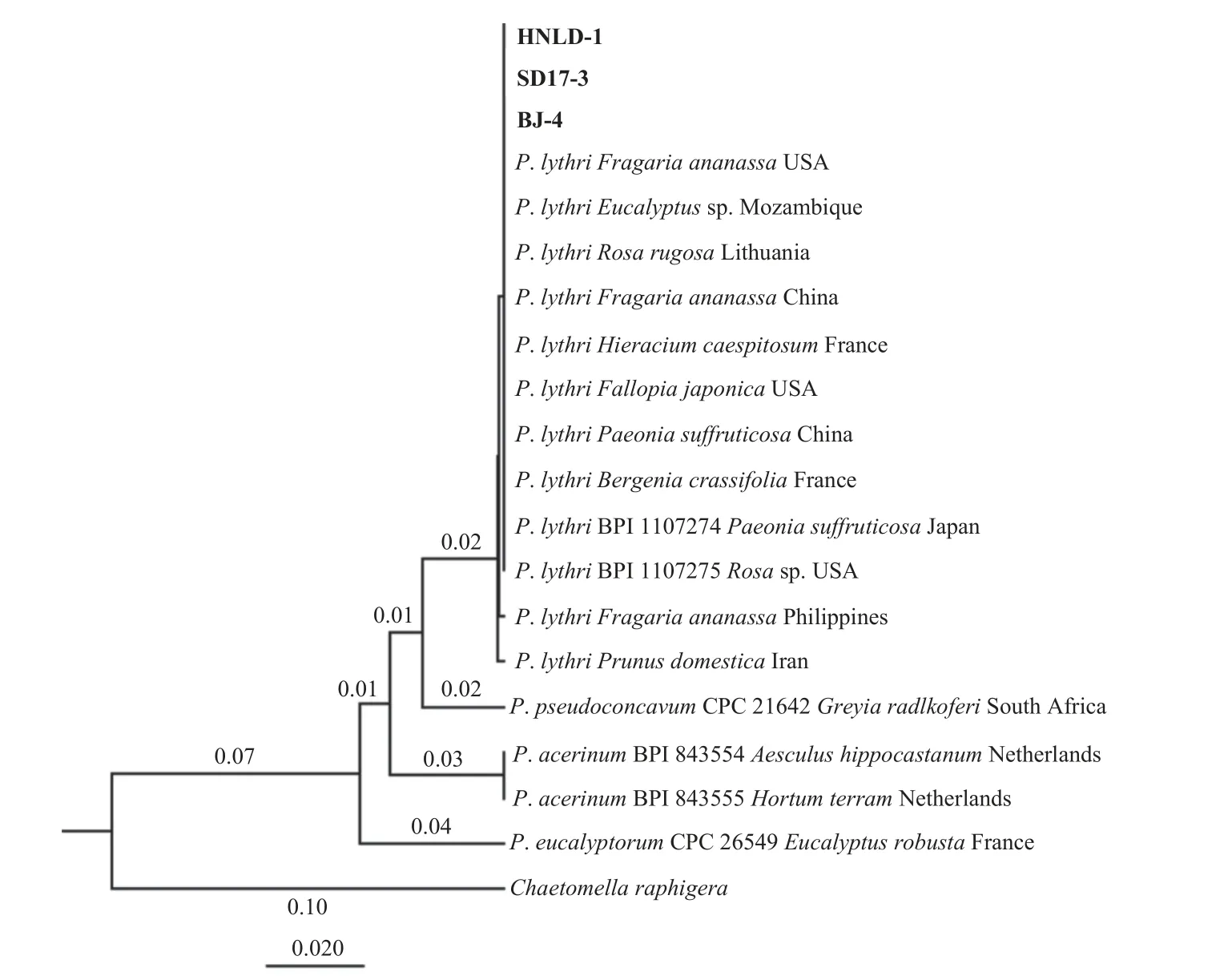
Fig.2 ITS phylogenetic tree of P.lythri strains using Bayesian Inference based on the JC + G model
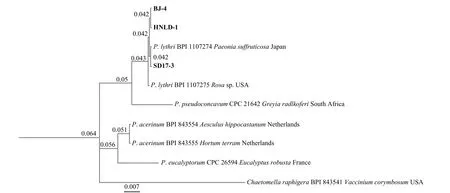
Fig.3 ITS and LSU phylogenetic tree of P.lythri, isolates using Bayesian Inference based on the models of JC + G and HKY + G
2.4 Fungicide sensitivity assessment in vitro
The sensitivities of the 26P.lythriisolates to nine fungicides were tested as follows (Table 3).The results showed that SYP-14288 had the strongest inhibitory effect on the mycelial growth ofP.lythri,with an average EC50value of (0.33 ± 0.06) μg/mL,which indicated that it could be used as an effective fungicide for controlling strawberry brown spot disease.Epoxiconazole, difenoconazole, prochloraz,and tebuconazole had better inhibitory effects andP.lythriwas relatively less sensitive to chlorothalonil,myclobutanil, and azoxystrobin.Mancozeb had the lowest toxicity, with an average EC50value of (336.16 ±158.21) μg/mL.
3 Discussion
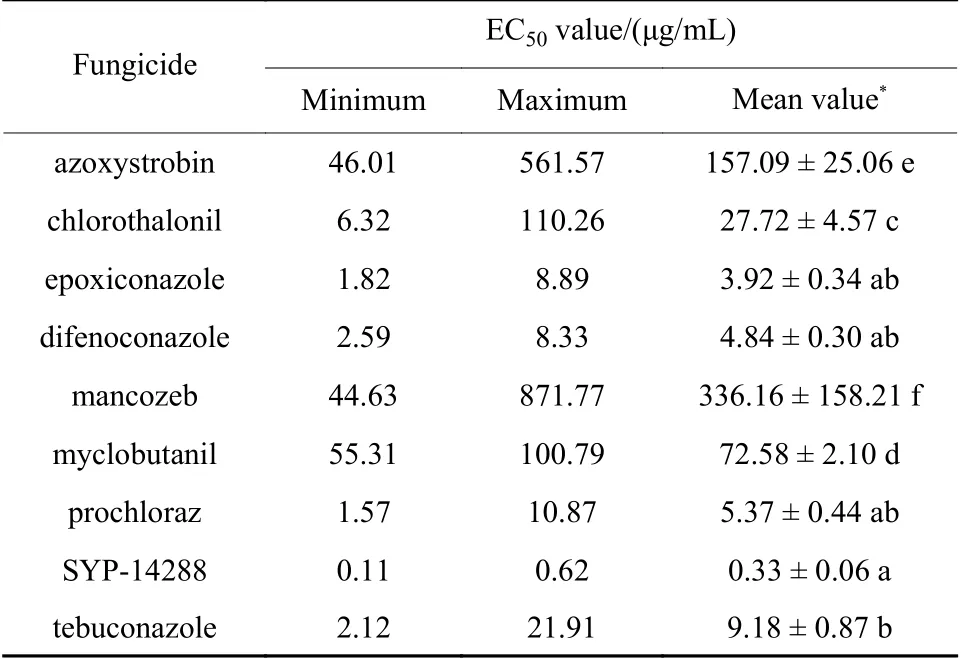
Table 3 Sensitivity of P.lythri isolates to nine fungicides in vitro
AmongPilidiumspp.,P.lythrihas been the most reported cause of plant diseases.P.lythriis a newly discovered strawberry tan-brown leaf spot disease in China[8].In this study, 26 isolates were isolated from strawberry tissues in China, morphological characterization of the isolates was completely consistent with the descriptions ofP.lythri(synanamorphP.concavumandH.lythri)[11-13,30].However, the sexual morph ofP.lythridescribed asD.oenotherae(Cooke & Ellis)Nannf.[31]was not observed.Nannfeldt (1932) placed this teleomorph in the monotypic genusDiscohainesiaNannf.as a member of the Dermateaceae, Leotiales[31].However, living cultures derived from ascospores do not exist.Palm[30]examined numerous specimens and provided a detailed description including growth characteristics for this species.The teleomorph is relatively uncommon and inconspicuous.Only sporodochia were formed on media tested and pycnidia were absent, in agreement with previous reports ofPilidiumrot on strawberries[7].Therefore,morphological identification was made only by mycelium and conidial characteristics.Moreover, 26 isolates were identified asP.lythriby phylogenetic analysis using ITS rDNA individually and concatenated combined datasets of ITS and LSU rDNA (Fig.2 and Fig.3).In China, the strawberry tan-brown spot disease caused byP.lythriwas first discovered in a greenhouse in Xingshou Town, Changping District,Beijing City[8], and this is the first report ofP.lythricaused tan-brown spot disease on strawberries in Zhucheng County, Shandong Province; and Loudi City, Hunan Province.
Currently, fungicides registered for the control of strawberry fungal diseases in China including azoxystrobin (quinone outside inhibitor, QoI),trifloxystrobin (QoI), difenoconazole (triazole),tebuconazole (triazole), and fluopyram (succinate dehydrogenase inhibitor, SDHI)[32].However, there are no fungicides registered to control tan-brown spot disease on strawberries caused byP.lythri.Furthermore,the symptoms of this disease in the field are very similar to strawberry anthracnose.The symptoms of these two diseases can easily be misinterpreted,which results in drug misuse and delay of the proper period of prevention and control of tan-brown spot disease on strawberries.Therefore, the control efficacy is not ideal.
In our study, three fungicides registered for controlling fungal diseases on strawberries(azoxystrobin, difenoconazole, and tebuconazole),five commonly used fungicides with different mechanisms and models of action, and SYP-14288 were selected as the test fungicides.The sensitivity of these nine fungicides on strawberries was determined by the mycelial growth rate method[29].SYP-14288 is a novel compound developed by the China Shenyang Research Institute of Chemical Industry, which is an environmentally friendly fungicide with low toxicity to mammals (unpublished data).SYP-14288 is highly effective against 32 important plant pathogens belonging to a range of taxonomic groupsin vitroand acts as an uncoupler of oxidative phosphorylation[33].Similar to the chemical structure of fluazinam, SYP-14288 is also a dinitroaniline compound, but its production cost is only one-third of that of fluazinam, and its activity against oomycetes is better than that of fluazinam[34].However, this product has not yet been registered in China.Our results showed that SYP-14288 has a strong inhibitory effect on the mycelial growth of 26 isolates ofP.lythri.Previous studies[35]have shown that SYP-14288 has excellent antimicrobial activity on the spore germination of tested pathogens including oomycetes, ascomycetes, conjugated fungi,and asexual fungi, and the antifungal activity on the spore germination stage of the same pathogen is generally higher than that on the mycelial growth.The effect of this agent on the spore production and mycelial growth ofP.lythrican be further explored in the future.The inhibition activity of mancozeb was the lowest, which was consistent with the results that the fungicidal activities of SYP-14288 againstB.cinerea,C.orbiculare,Sclerotinia sclerotiorum,Rhizoctonia solani,Alternaria alternata, andMacrophoma kawatsukaiwere higher than those of chlorothalonil and mancozeb[36].These results indicated that SYP-14288 could be used as an effective fungicide for the control of tan-brown spot disease on strawberries.
The multiple of the maximum EC50value and the minimum EC50value of azoxystrobin, chlorothalonil,mancozeb, and tebuconazole was higher than 10 times.It has been speculated that the isolates have developed resistance to these fungicides.As reported,azoxystrobin, chlorothalonil, and mancozeb have been widely used to control strawberry fungal diseases in China, such as strawberry root rot disease, anthracnose, grey mold, and powdery mildew[37].A single fungicide used extensively for a long time can easily cause resistance.Therefore, we suggest the alternative use of different fungicides that have different mechanisms and models of action to control tan-brown spot disease on strawberries, such as the application of SYP-14288 alternately with QoI, DMI, and SDHI fungicides.This study was carried out onlyin vitro,and could not represent the actual application effect of the fungicides in the field, where the mechanism of action, the inner-absorption conducting properties,and other factors may affect the efficacy of practical application.Therefore, in order to accurately guide the control of strawberry disease, field experiments need to be further verified and the biocides be applied alternately.
